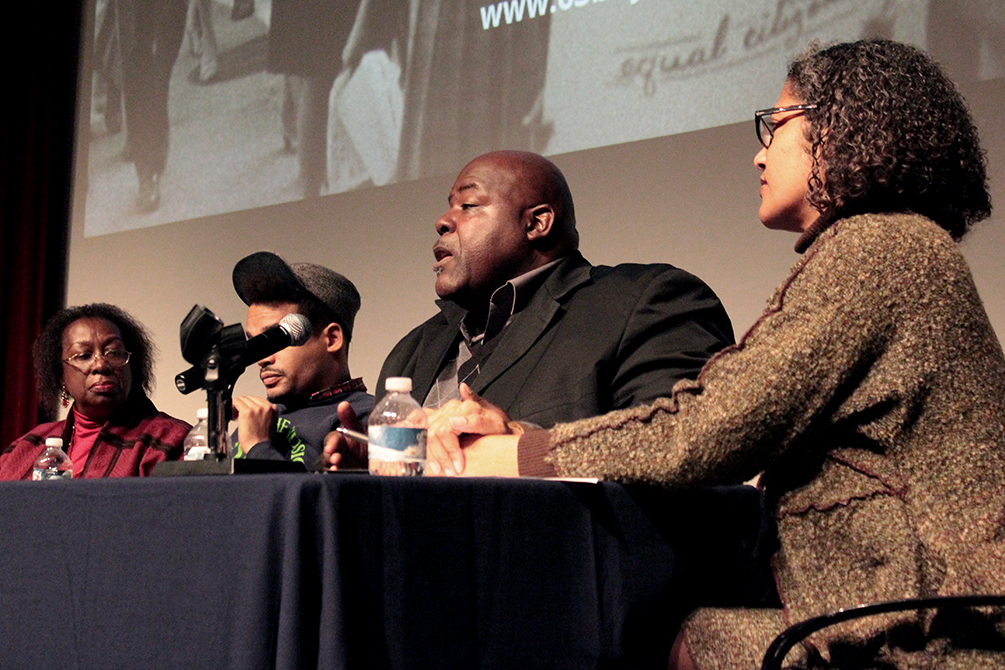
On October 22, 1963, over 200,000 students in Chicago skipped school. They weren’t playing hooky; they were protesting the inferior education black students received in Chicago Public Schools. University of Chicago student Gordon Quinn and his friends decided to pick up some film stock left over from another project, ignore the due date on their camera rental, and interview the protestors.
Fifty years later, CPS decided to go through with the largest round of school closings in American history and Quinn decided it was time to put that footage to good use. Quinn’s documentary company, Kartemquin Films, is in the middle of creating a short documentary of the 1963 boycott to be shown in classrooms today. Earlier this week, on the fiftieth anniversary of the movement known as “Freedom Day,” visitors at the DuSable Museum packed the screening room to catch a twenty-minute preview.
The 16mm film shows a world that is harshly divided into black and white. Dr. Timuel Black, speaking at a panel after the screening, said that CPS Superintendent Ben Willis “was brought in with one mission: to bring the schools into complete segregation.” If a black school was overcrowded, Willis would keep the spillovers penned in trailers in the parking lot. In Englewood, some parents lay down in front of bulldozers to prevent these “Willis Wagons” from being built. Inspired by the March on Washington, organizers decided that they needed a citywide boycott of CPS.
Hundreds of thousands of students, parents, and teachers participated. Twenty-five thousand students marched peacefully down Michigan Avenue; at the DuSable, the audience gasped out loud when they saw the size of the crowd on screen. Earlier, the film had flown over Freedom Day headquarters, where busy volunteers crouched over phones and shouted out the latest statistics: “Forrestville North has eight students in it out of a total of twelve hundred….Fifteen hundred out at the Copernicus school….At least fifteen schools have a virtual total boycott.” .
CPS lost $470,000 in a single day. Local headlines read, “225,000 Kids Make Willis Eat Jim Crow.” It took one more “Freedom Day,” a year later, but Willis was finally fired.
The film showed a crowd filled with youthful energy but adult determination. Toddlers and high schoolers came out, laughing and roughhousing with their friends sometimes, but very sure of why they were there. “Today is Freedom Day!” shouted one boy. The crowd joined in song, sometimes in the style of old spirituals. “Oooooh, freedom,” they sang, “nooooo more school board!”
The names of many of the high-spirited students shown in the film, however, have been lost. Though Kartemquin is done with two-thirds of the film, they’re still looking for participants to interview today. Quinn urged audience members to help them find more boycott participants through their website, 63boycott.com. Users can explore a trove of stills from the film, and tag the faces of people they recognize.
If the film’s continued relevance wasn’t already obvious, Kartemquin included footage of recent protests against the school closings. The chants and slogans are much the same, with “Willis” merely being replaced by “Emanuel.” After the film, activists from the past and present talked more about the history of Freedom Day, modern problems like the school-to-prison pipeline, and the lessons to be learned from the boycott.
“The movement never comes from the top,” said Rosie Simpson, one of the parents who chained themselves to bulldozers. Most of the leadership, she said, was just there to give speeches. The real power came from regular parents and teachers who were mad as hell about what they saw as an inferior education for their children.
Marguerite Mariama-Moore, one of several audience members who had attended the boycott, said that listening to the panel made her feel hopeful about the power of collective consciousness. She wondered, though, if today’s generation is “ready to sacrifice” as much as the last generation did.
In the words of one of the teachers interviewed in the film, “The children of Chicago showed the very best of themselves” that day. If given the chance to learn their own history, students today might just achieve the same.
